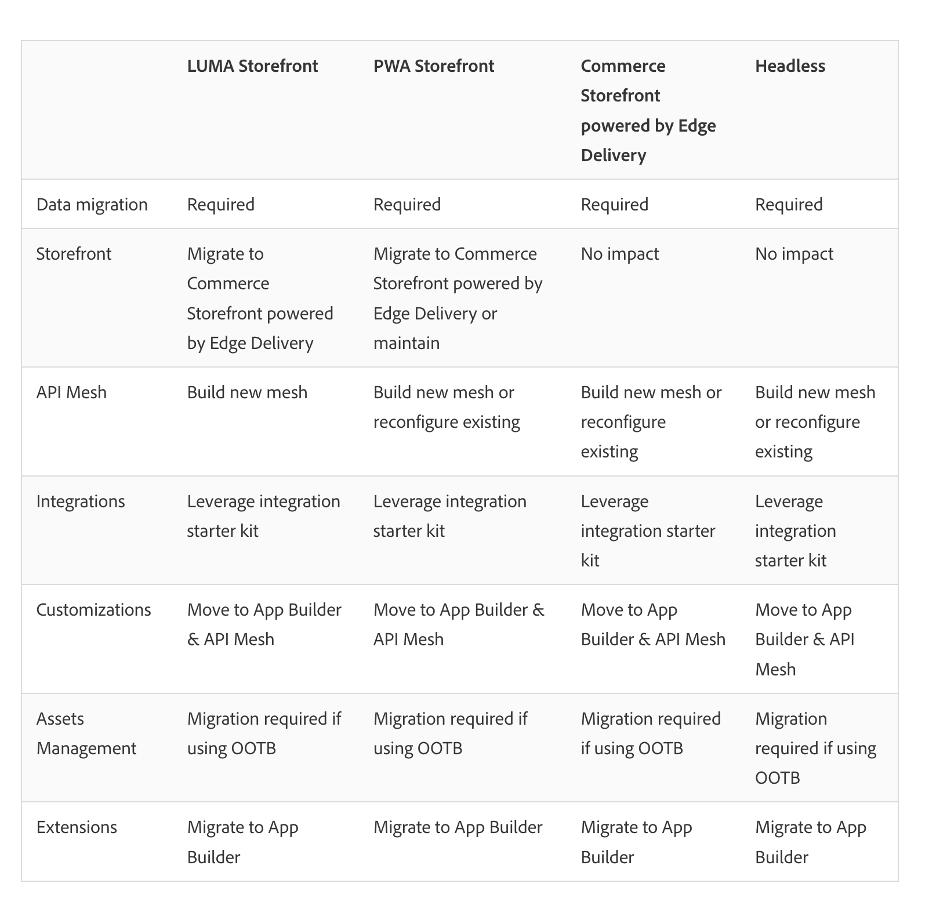
Demystifying Adobe Commerce as a Cloud Service


In March of 2025, at their annual Summit event, Adobe announced Adobe Commerce as a Cloud Service (“ACCS”), an exciting new offering for their existing Commerce product (“PaaS”). Since becoming generally available in the summer of 2025, ACCS has become a frequent discussion point in conversations I have with merchants currently on or interested in the Adobe Commerce solution. The goal of this post is to clear up some frequently asked questions from these discussions and share my viewpoint on ACCS for merchants.
The Benefits of ACCS
No More Upgrades
“No more upgrades” is perhaps the main headline here. Like other SaaS platforms, with the ACCS model, the Adobe Commerce instance is provided “as a service”. This means merchants no longer need to worry about upgrading the platform. Adobe Commerce platform upgrades have historically been viewed as a maintenance expense rather than a functional enhancement and merchants are typically not excited about them. With ACCS, merchants no longer need to worry about the cost of regular upgrades as that responsibility is now covered by Adobe. This includes both the Adobe Commerce core platform, as well as services like PHP and MariaDB.
Cost aside, there are also clear security benefits as the merchant no longer needs to worry about getting breached because they didn’t patch/upgrade fast enough. It’s also one less thing to worry about for PCI compliance.
Cutting Edge Frontend
Adobe Commerce’s frontend journey to date has been rocky. Magento 2 initially launched with the Luma theme, however it has received little to no investment since Adobe acquired the product. PWA Studio showed some promise initially, but that ultimately also fizzled out. A number of alternative community driven frontends have emerged over the years to address this gap, including headless options like Vue Storefront or monoliths like Hyva Theme. With ACCS, Adobe has made a clear commitment to Adobe Commerce Storefront, powered by Edge Delivery Services. The site speed and usability enhancements of this new frontend are crystal clear as demonstrated in our talk “How Bungie Store Boosted Speed & Scale with Adobe Experience Manager” from Adobe Summit 2025.
Improved Content Management System with AEM Universal Editor
The new Adobe Commerce Storefront integrates with AEM’s Universal Editor, a big step forward when compared to PaaS’s native Page Builder functionality. To name a few, Universal Editor offers first class experimentation (A/B testing) features, content drafts and improved preview experience. Merchants who opt to include AEM Universal Editor in their license will see clear benefits in the content management experience.
Stop Worrying About Scaling
The default Adobe Commerce Cloud (PaaS) architecture required merchants to fret about submitting support tickets to upsize their cluster prior to peak traffic events. With ACCS, this is no longer a concern as the infrastructure and scaling is fully the responsibility of Adobe.
Expanded Developer Pool
“Magento Developer” has historically been a niche role, requiring specialized knowledge of core extension points like Interceptors, or UI Components and a bespoke tech stack including backend PHP code and Magento’s custom flavor of KnockoutJS. ACCS implementations will be built with NodeJS, React and JavaScript, expanding the pool of engineering talent.
The Risks
It’s VERY New
As of the time of writing this article it has been less than a year since the announcement of the product and less than 6 months since it became generally available. As system integrators no longer have the ability to change the behavior of the core Commerce engine, Adobe has been building new capabilities for customization such as Custom Attributes for additional entities like orders. Use cases haven’t yet been fully fleshed out and the product hasn’t undergone the same amount of production battle testing as the PaaS product. As such, at this point, there will be more kinks that come up during a SaaS implementation than there would be with PaaS.
Limited Marketplace Ecosystem
The PaaS version of Adobe opens the door to a rich marketplace ecosystem that has grown over nearly 20 years since Magento 1 originally came out in 2008. With ACCS these extensions cannot be installed. An ecosystem of apps published to Adobe Exchange is emerging, however it’s limited to just shy of 100 as of the time of writing this. This means it’s more likely that code will need to be custom developed to integrate Adobe Commerce with third-party systems or customize behavior during your project.
Document Based Authoring
While the integration with the AEM Universal Editor is a major selling point for ACCS, the alternative for merchants who don’t license AEM is an unintuitive approach where pages are managed as documents, either using Adobe’s Document Authoring tool (pictured below), or a merchant provided Google Drive or Sharepoint site. Enterprise-level merchants are unlikely to be satisfied with this clunky content management approach.

The Migration Path
Migration to ACCS is a major initiative that may border on a complete rebuild depending on how your current Adobe Commerce project is implemented. Adobe provides an excellent table covering various use cases.

The Frontend
ACCS does not support traditional themes and must utilize a headless approach. If your site is using a Luma based theme, or an alternate monolithic theme such as Hyva, moving to ACCS will require a complete frontend rebuild. However, as noted in “The Benefits of ACCS”, moving to Adobe’s new Commerce Storefront will offer significant benefits when compared to your current frontend. If your site is using an existing headless solution other than EDS, it may be possible to continue to use it.
The Backend
Any customizations and integrations that are currently implemented using marketplace or custom extensions will need to be migrated. Some marketplace extensions may exist on Adobe Exchange, however custom code will need to be rewritten. Depending on the level of customization, this step could be a heavy lift.
Your Database
Your database will need to be migrated off your existing PaaS or on-premise instance. Fortunately, the core schema will be portable without any headaches, however any data stored in additional tables or columns will need to be moved elsewhere.
Rightpoint’s Approach
For most merchants, we recommend an incremental approach, rather than trying to tackle the entire migration in a single big bang release. Rightpoint recommends prioritizing the frontend migration as that will present the largest value add and migrating backend customizations secondarily. The steps involved would be as follows:
Upgrade the existing Adobe Commerce instance to the latest version
Implement Catalog Service for Adobe Commerce
Implement Adobe Commerce Storefront (EDS)
Move backend customizations to App Builder
Complete ACCS migration
What is Adobe Commerce Optimizer
ACCS wasn’t the only Adobe Commerce product announced in March of 2025. Meant as a bridge between your existing commerce backend system and the Adobe ecosystem, Adobe Commerce Optimizer (ACO) offers the ability to leverage Adobe’s frontend catalog capabilities such as live search and product recommendations without a full replatform. The ACO use case is more relevant for merchants running a legacy commerce system (read: not Adobe Commerce) who are interested in composing together Adobe's search and discovery experience alongside their existing commerce system. ACO is not a full commerce platform, unlike Adobe Commerce. Merchants should know that some of the work they do to get on ACO will ultimately wind up being discarded (catalog ingest and session sharing) if they intend to move away from their existing commerce system entirely.
Conclusion
The value of ACCS is clear and there’s no question that Adobe will continue to invest heavily in it. However, as the product is still young, early adopters should expect road bumps during an implementation.
Rightpoint has extensive experience with ACC’s EDS frontend and backend customizations using App Builder and would love to talk to you about your ecommerce platform selection and total cost of ownership.


